oil level TOYOTA CAMRY 2011 XV50 / 9.G Owners Manual
[x] Cancel search | Manufacturer: TOYOTA, Model Year: 2011, Model line: CAMRY, Model: TOYOTA CAMRY 2011 XV50 / 9.GPages: 554, PDF Size: 9.69 MB
Page 6 of 554
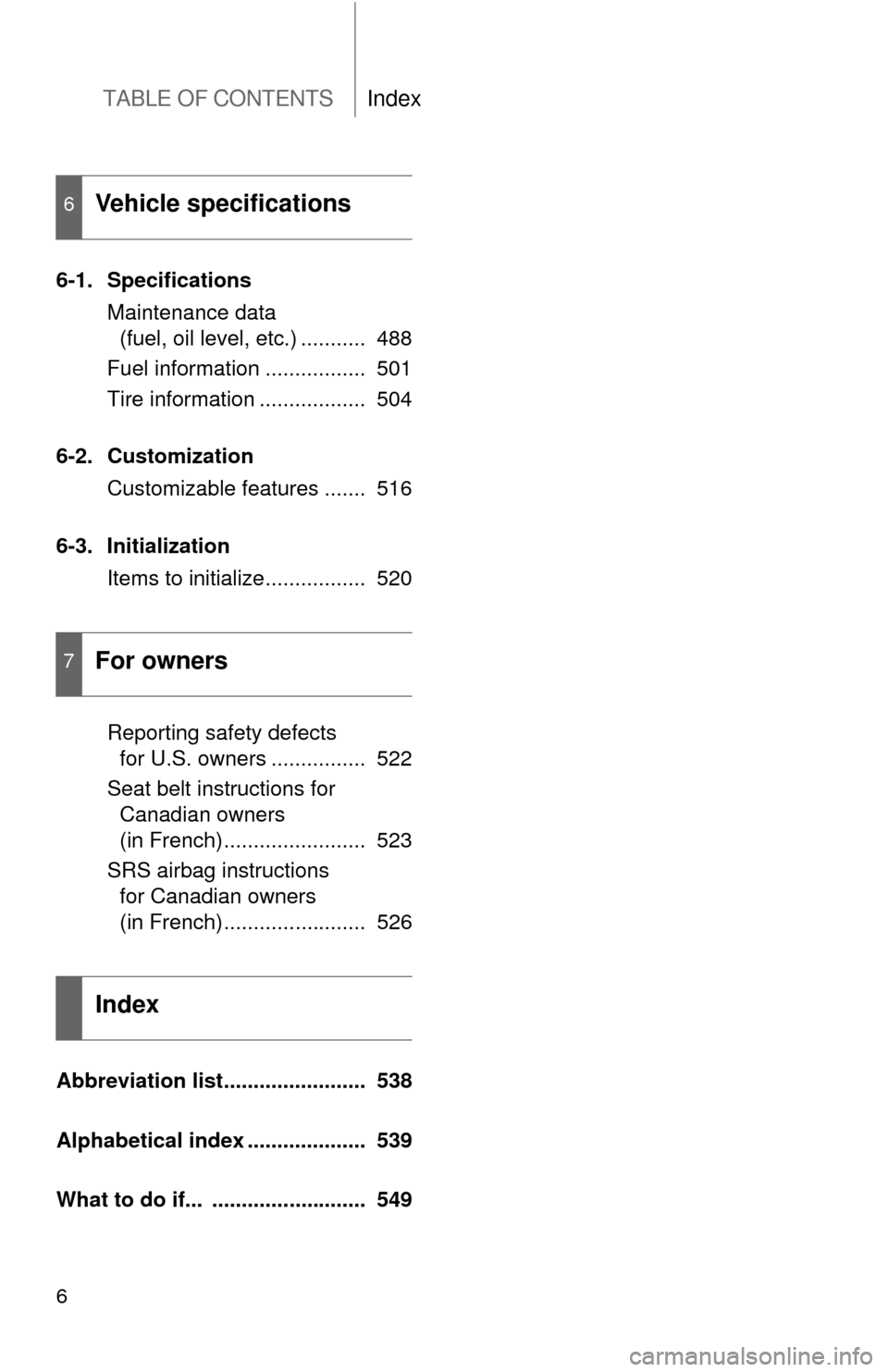
TABLE OF CONTENTSIndex
6
6-1. SpecificationsMaintenance data (fuel, oil level, etc.) ........... 488
Fuel information ................. 501
Tire information .................. 504
6-2. Customization Customizable features ....... 516
6-3. Initialization Items to initialize................. 520
Reporting safety defects for U.S. owners ................ 522
Seat belt instructions for Canadian owners
(in French) ........................ 523
SRS airbag instructions for Canadian owners
(in French) ........................ 526
Abbreviation list........................ 538
Alphabetical index .................... 539
What to do if... .......................... 549
6Vehicle specifications
7For owners
Index
Page 183 of 554
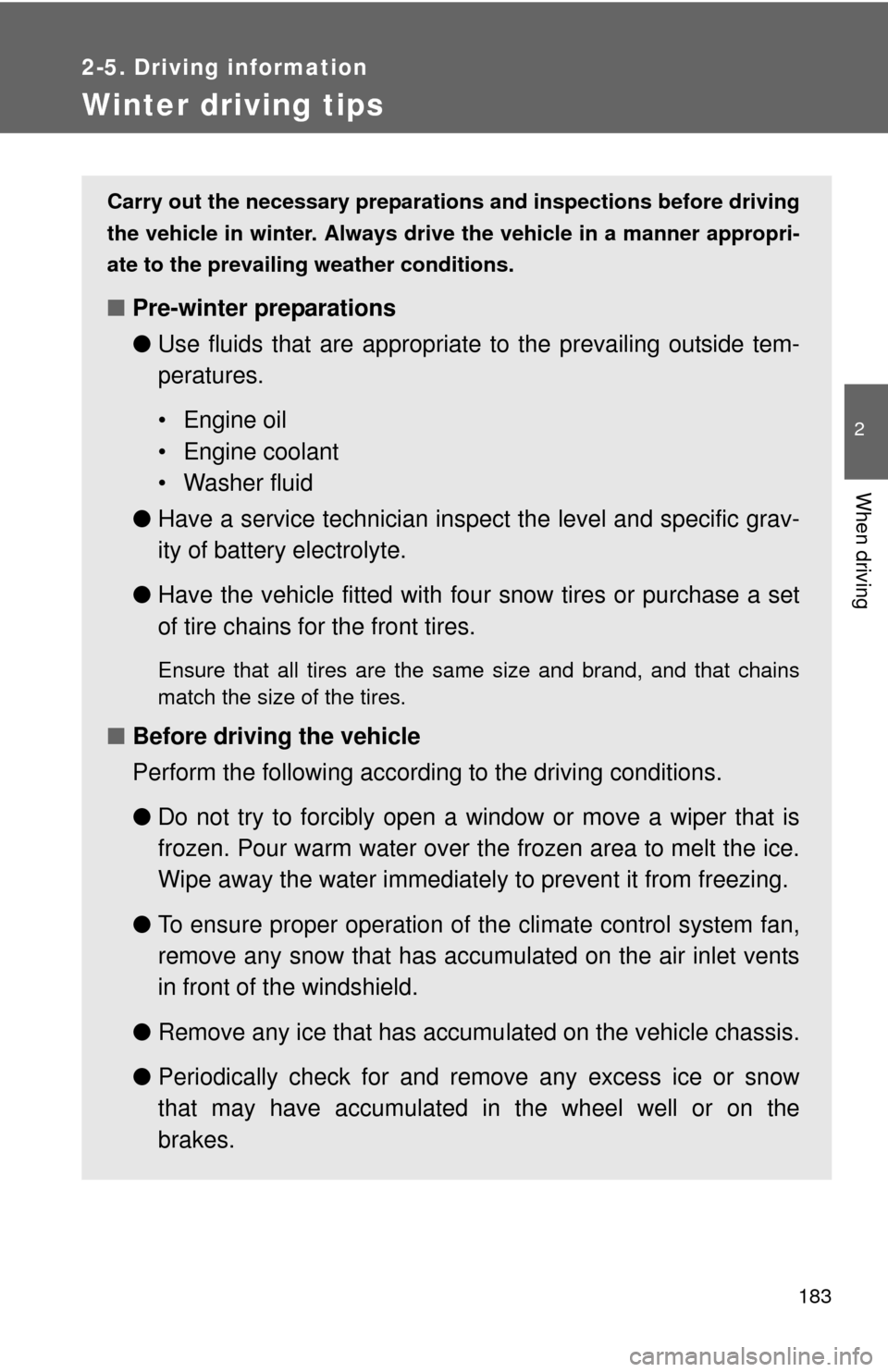
183
2-5. Driving information
2
When driving
Winter driving tips
Carry out the necessary preparations and inspections before driving
the vehicle in winter. Always drive the vehicle in a manner appropri-
ate to the prevailing weather conditions.
■ Pre-winter preparations
●Use fluids that are appropriate to the prevailing outside tem-
peratures.
• Engine oil
• Engine coolant
• Washer fluid
● Have a service technician inspect the level and specific grav-
ity of battery electrolyte.
● Have the vehicle fitted with four snow tires or purchase a set
of tire chains for the front tires.
Ensure that all tires are the same size and brand, and that chains
match the size of the tires.
■Before driving the vehicle
Perform the following according to the driving conditions.
●Do not try to forcibly open a window or move a wiper that is
frozen. Pour warm water over the frozen area to melt the ice.
Wipe away the water immediately to prevent it from freezing.
● To ensure proper operation of th e climate control system fan,
remove any snow that has accumulated on the air inlet vents
in front of the windshield.
● Remove any ice that has accumu lated on the vehicle chassis.
● Periodically check for and remove any excess ice or snow
that may have accumulated in the wheel well or on the
brakes.
Page 362 of 554
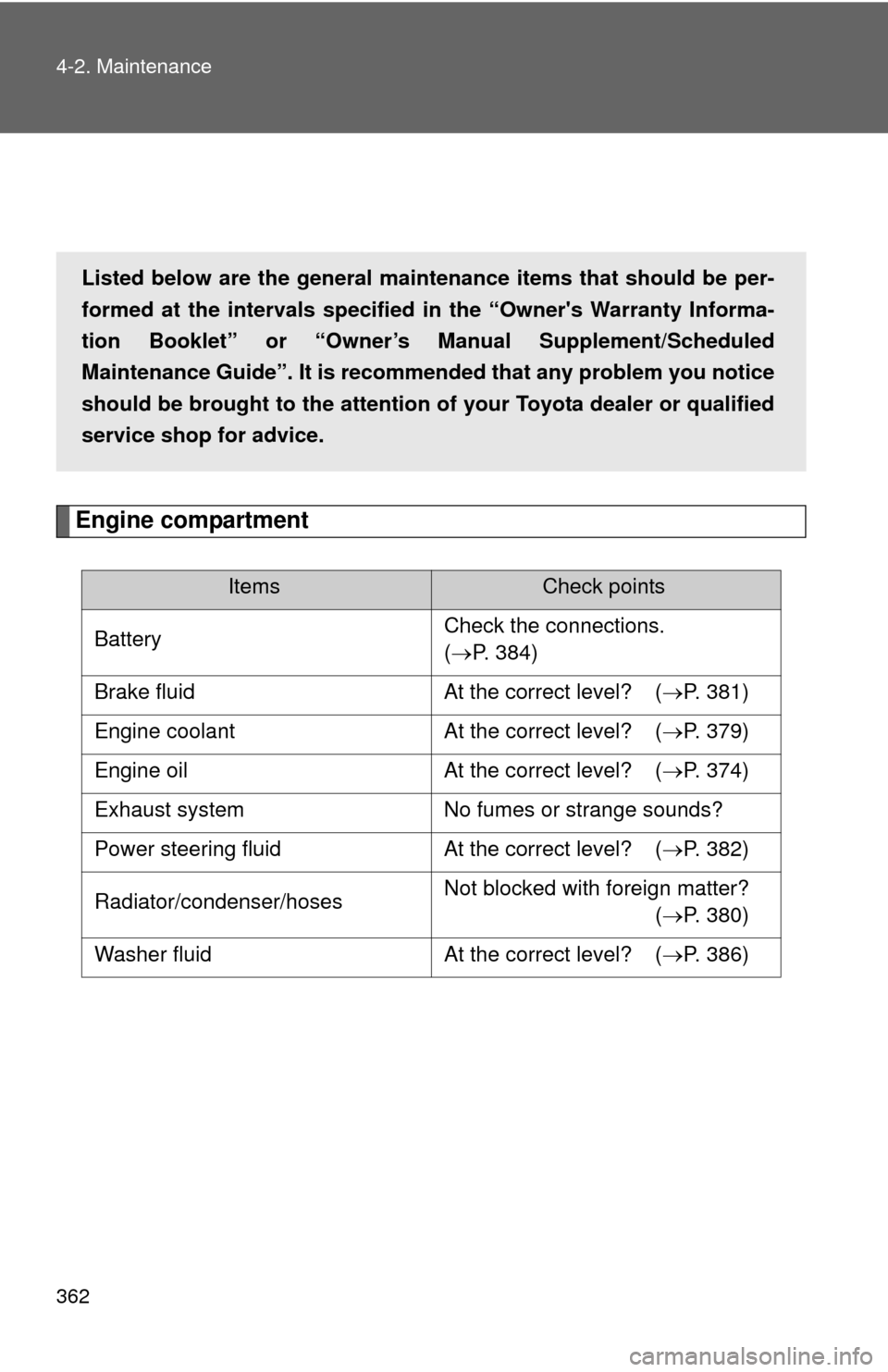
362 4-2. Maintenance
General maintenance
Engine compartment
ItemsCheck points
Battery Check the connections.
(
P. 384)
Brake fluid At the correct level? ( P. 381)
Engine coolant At the correct level? ( P. 379)
Engine oil At the correct level? ( P. 374)
Exhaust system No fumes or strange sounds?
Power steering fluid At the correct level? ( P. 382)
Radiator/condenser/hoses Not blocked with foreign matter?
(
P. 380)
Washer fluid At the correct level? ( P. 386)
Listed below are the general maintenance items that should be per-
formed at the intervals specified in the “Owner's Warranty Informa-
tion Booklet” or “Owner’s Manual Supplement/Scheduled
Maintenance Guide”. It is recommended that any problem you notice
should be brought to the attention of your Toyota dealer or qualified
service shop for advice.
Page 366 of 554
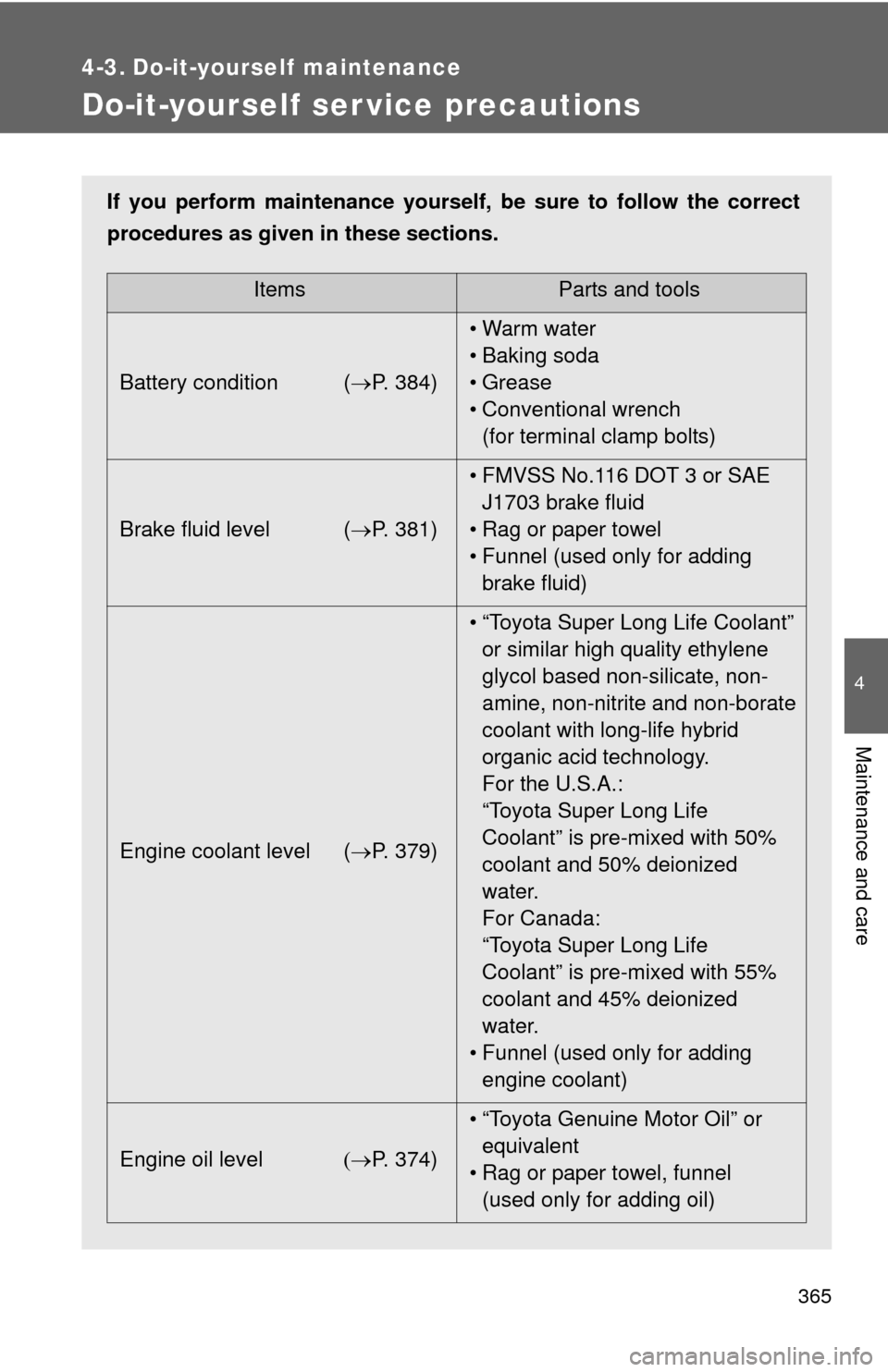
365
4
Maintenance and care
4-3. Do-it-yourself maintenance
Do-it-yourself ser vice precautions
If you perform maintenance yourself, be sure to follow the correct
procedures as given in these sections.
ItemsParts and tools
Battery condition ( P. 384)•Warm water
• Baking soda
• Grease
• Conventional wrench
(for terminal clamp bolts)
Brake fluid level ( P. 381)• FMVSS No.116 DOT 3 or SAE
J1703 brake fluid
• Rag or paper towel
• Funnel (used only for adding brake fluid)
Engine coolant level ( P. 379)• “Toyota Super Long Life Coolant”
or similar high quality ethylene
glycol based non-silicate, non-
amine, non-nitrite and non-borate
coolant with long-life hybrid
organic acid technology.
For the U.S.A.:
“Toyota Super Long Life
Coolant” is pre-mixed with 50%
coolant and 50% deionized
water.
For Canada:
“Toyota Super Long Life
Coolant” is pre-mixed with 55%
coolant and 45% deionized
water.
• Funnel (used only for adding engine coolant)
Engine oil level P. 374) • “Toyota Genuine Motor Oil” or
equivalent
• Rag or paper towel, funnel (used only for adding oil)
Page 367 of 554
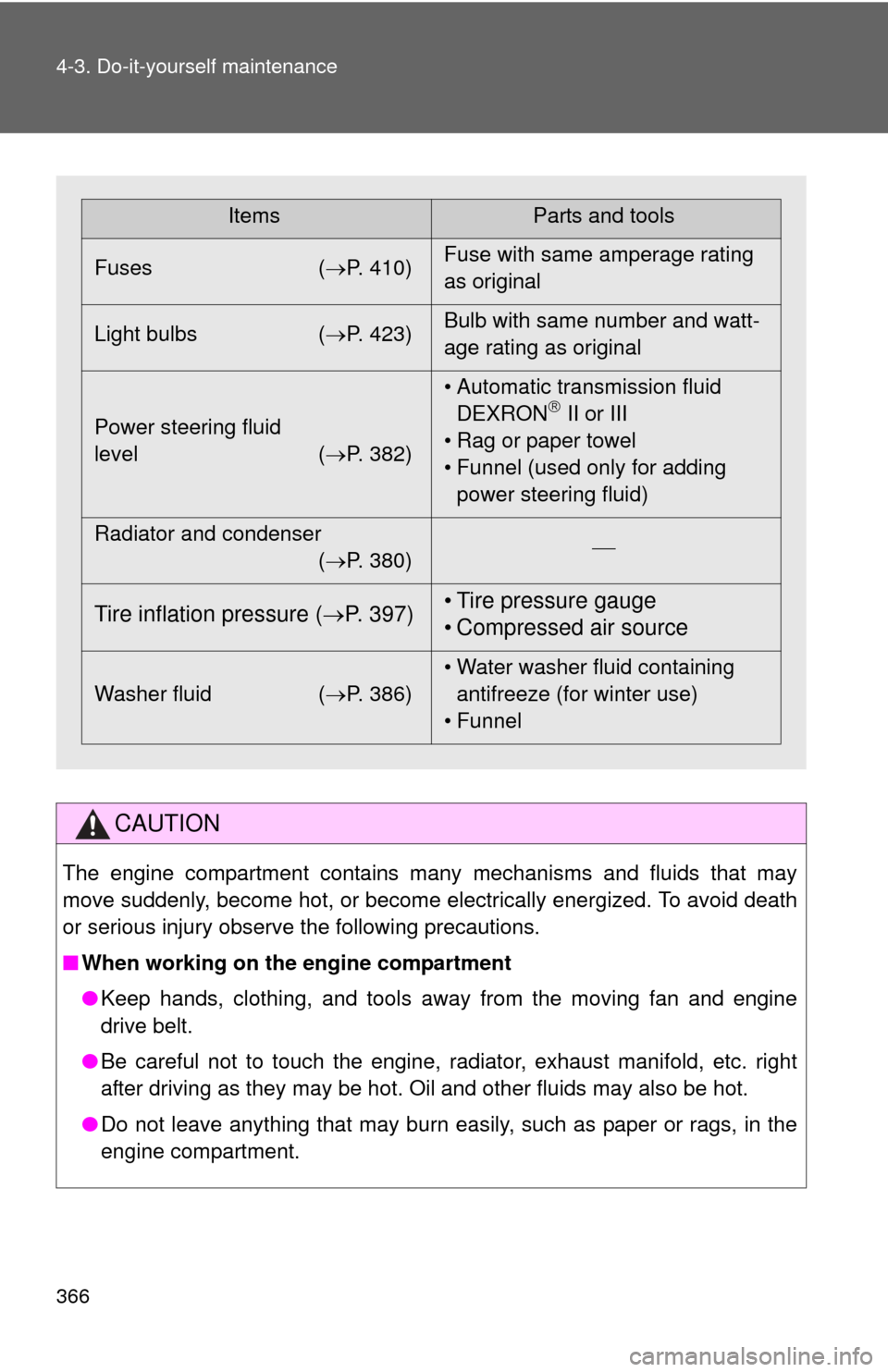
366 4-3. Do-it-yourself maintenance
CAUTION
The engine compartment contains many mechanisms and fluids that may
move suddenly, become hot, or become electrically energized. To avoid death
or serious injury observe the following precautions.
■When working on the engine compartment
●Keep hands, clothing, and tools away from the moving fan and engine
drive belt.
● Be careful not to touch the engine, radiator, exhaust manifold, etc. right
after driving as they may be hot. Oil and other fluids may also be hot.
● Do not leave anything that may burn easily, such as paper or rags, in the
engine compartment.
ItemsParts and tools
Fuses ( P. 410)Fuse with same amperage rating
as original
Light bulbs ( P. 423)Bulb with same number and watt-
age rating as original
Power steering fluid
level ( P. 382)• Automatic transmission fluid
DEXRON
II or III
• Rag or paper towel
• Funnel (used only for adding power steering fluid)
Radiator and condenser (P. 380)
Tire inflation pressure (
P. 397) • Tire pressure gauge
• Compressed air source
Washer fluid
(P. 386) • Water washer fluid containing
antifreeze (for winter use)
• Funnel
Page 372 of 554
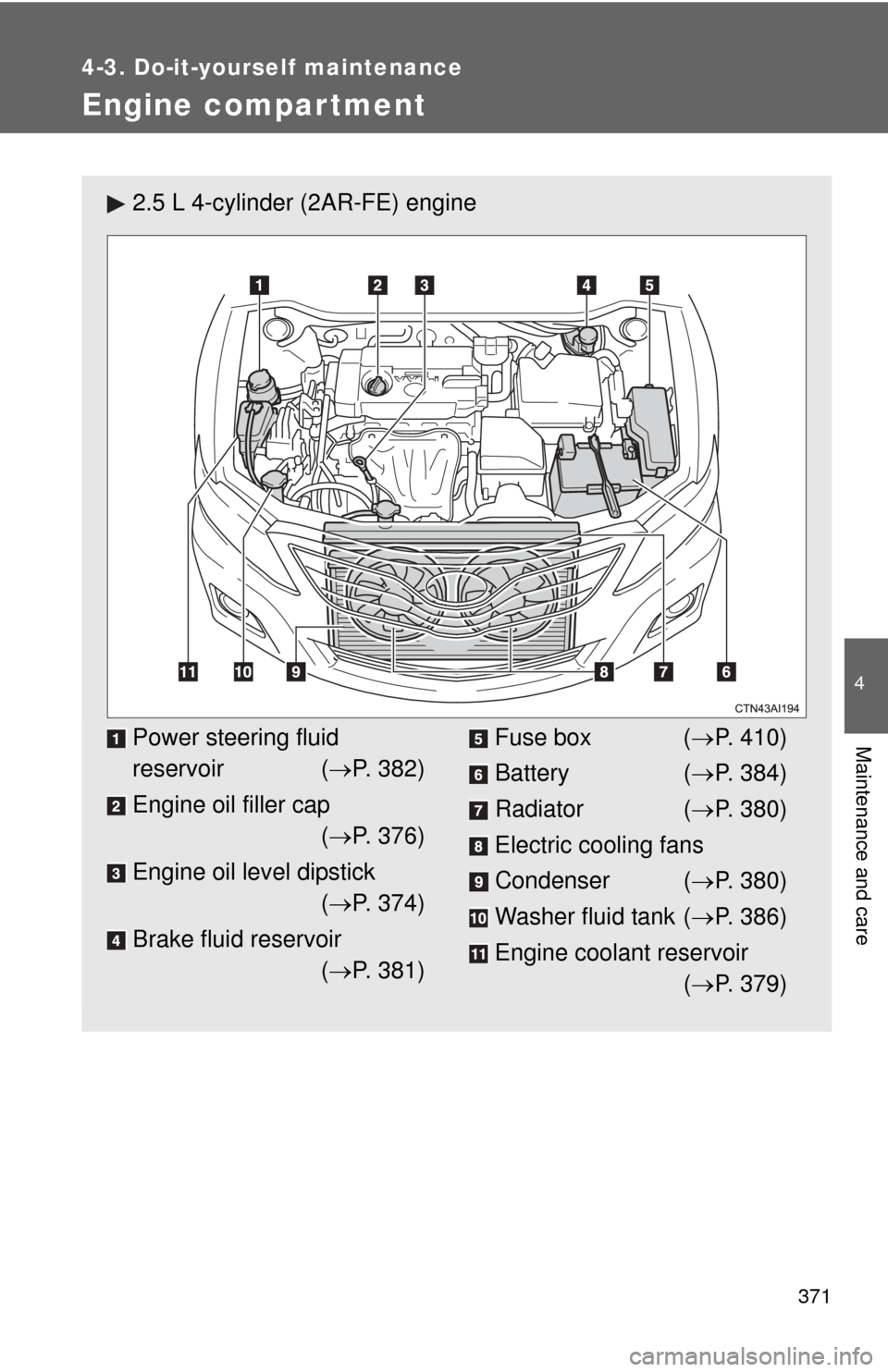
371
4-3. Do-it-yourself maintenance
4
Maintenance and care
Engine compar tment
2.5 L 4-cylinder (2AR-FE) engine
Power steering fluid
reservoir (P. 382)
Engine oil filler cap ( P. 376)
Engine oil level dipstick ( P. 374)
Brake fluid reservoir ( P. 381)Fuse box ( P. 410)
Battery ( P. 384)
Radiator ( P. 380)
Electric cooling fans
Condenser ( P. 380)
Washer fluid tank ( P. 386)
Engine coolant reservoir ( P. 379)
Page 373 of 554
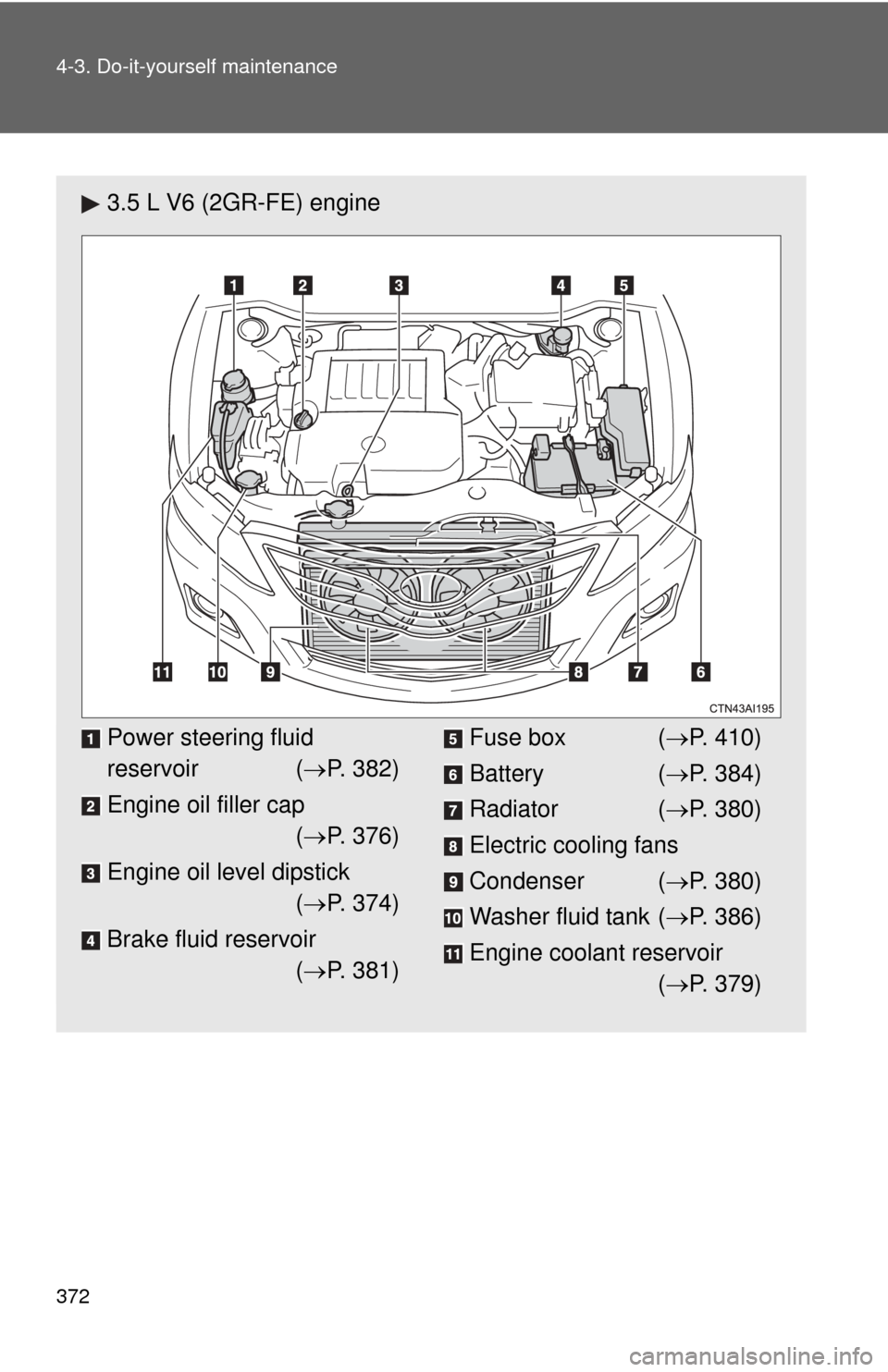
372 4-3. Do-it-yourself maintenance
3.5 L V6 (2GR-FE) engine
Power steering fluid
reservoir (P. 382)
Engine oil filler cap ( P. 376)
Engine oil level dipstick ( P. 374)
Brake fluid reservoir ( P. 381)Fuse box ( P. 410)
Battery ( P. 384)
Radiator ( P. 380)
Electric cooling fans
Condenser ( P. 380)
Washer fluid tank ( P. 386)
Engine coolant reservoir ( P. 379)
Page 375 of 554
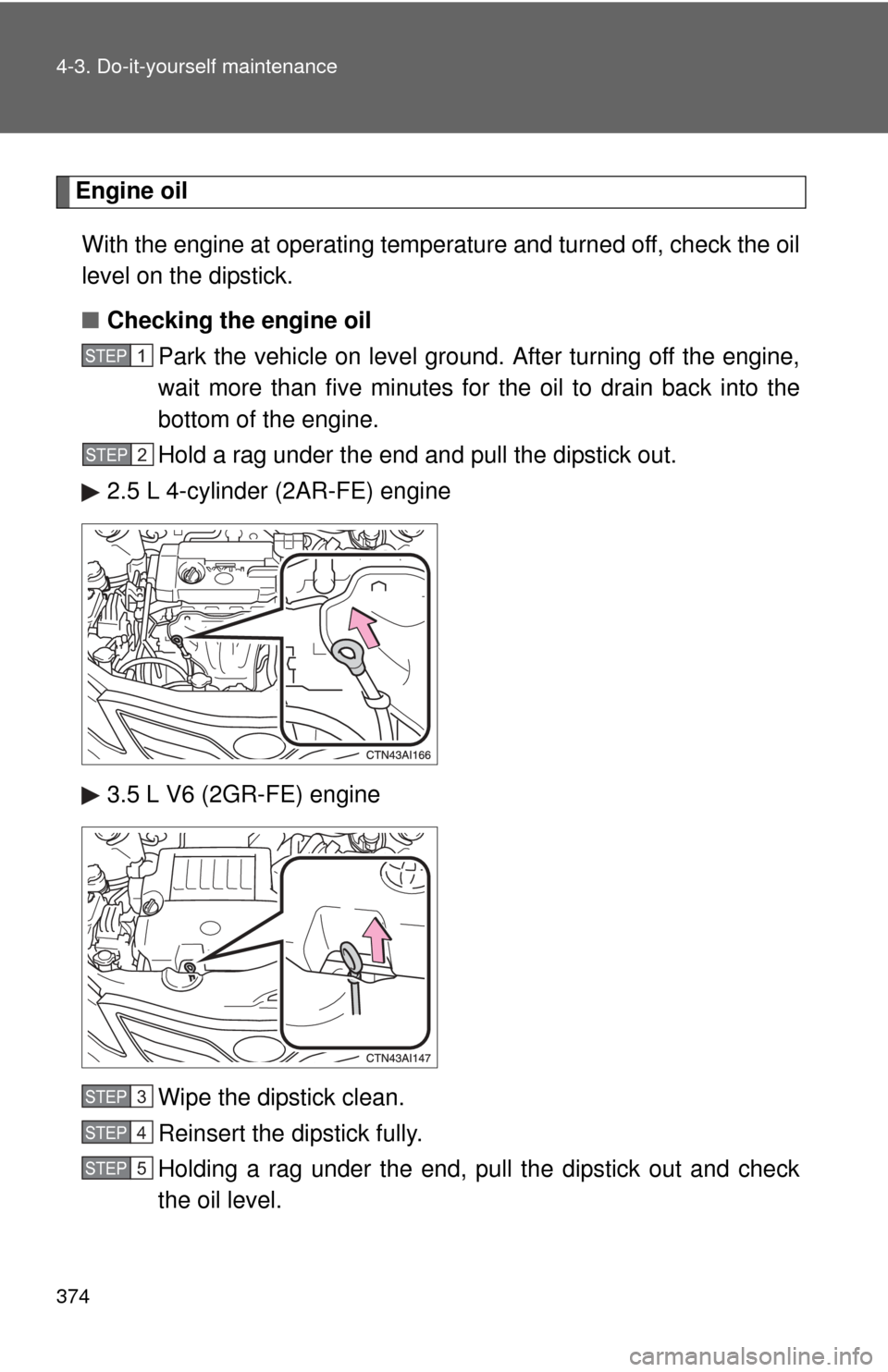
374 4-3. Do-it-yourself maintenance
Engine oilWith the engine at operating temperature and turned off, check the oil
level on the dipstick.
■ Checking the engine oil
Park the vehicle on level gro und. After turning off the engine,
wait more than five minutes for the oil to drain back into the
bottom of the engine.
Hold a rag under the end and pull the dipstick out.
2.5 L 4-cylinder (2AR-FE) engine
3.5 L V6 (2GR-FE) engine
Wipe the dipstick clean.
Reinsert the dipstick fully.
Holding a rag under the end, pull the dipstick out and check
the oil level.
STEP1
STEP2
STEP3
STEP4
STEP5
Page 377 of 554
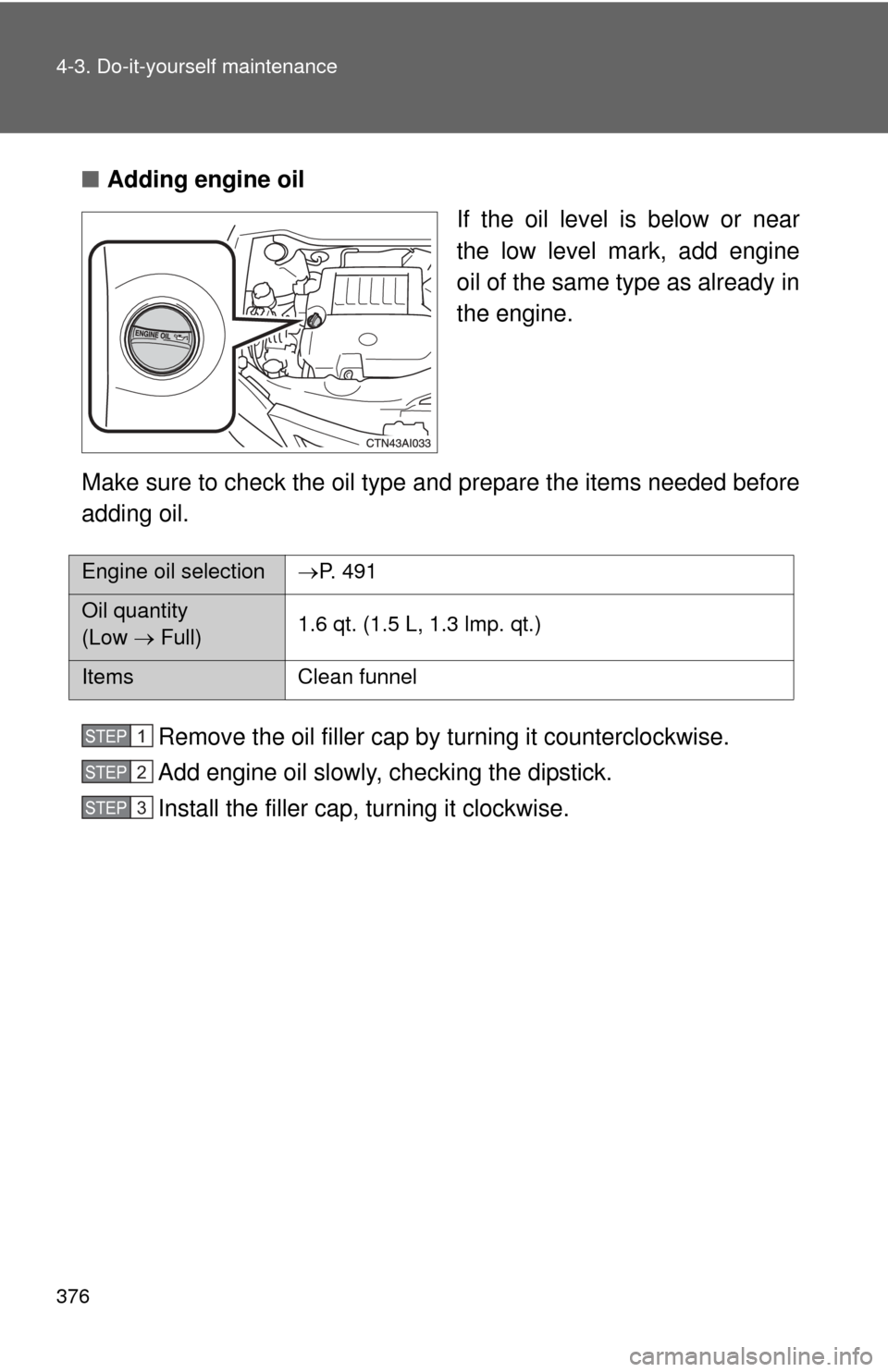
376 4-3. Do-it-yourself maintenance
■Adding engine oil
If the oil level is below or near
the low level mark, add engine
oil of the same type as already in
the engine.
Make sure to check the oil type and prepare the items needed before
adding oil.
Remove the oil filler cap by turning it counterclockwise.
Add engine oil slowly, checking the dipstick.
Install the filler cap, turning it clockwise.
Engine oil selection P. 4 9 1
Oil quantity
(Low Full)1.6 qt. (1.5 L, 1.3 lmp. qt.)
Items
Clean funnel
STEP1
STEP2
STEP3
Page 378 of 554
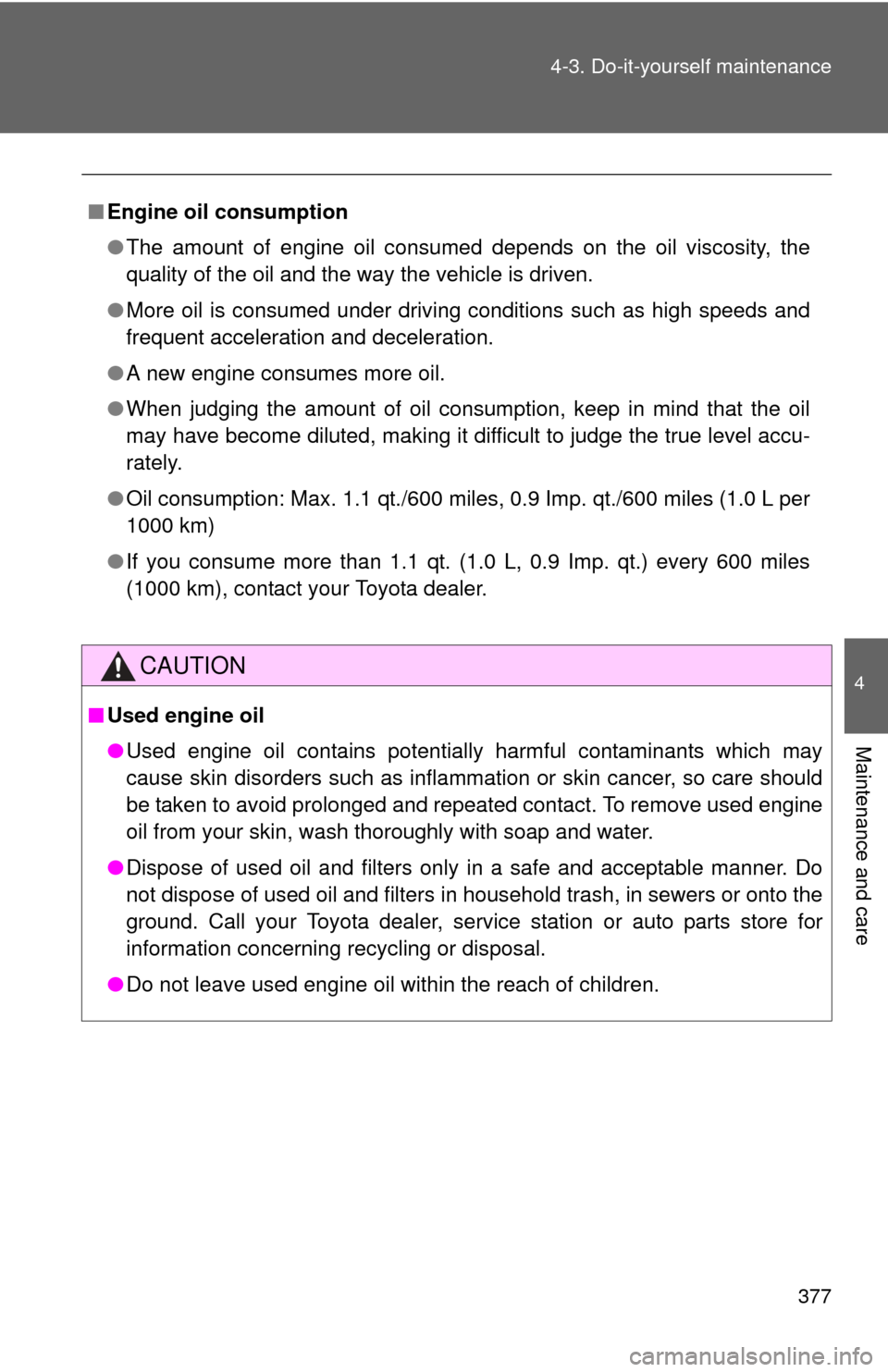
377
4-3. Do-it-yourself maintenance
4
Maintenance and care
■
Engine oil consumption
●The amount of engine oil consumed depends on the oil viscosity, the
quality of the oil and the way the vehicle is driven.
● More oil is consumed under driving conditions such as high speeds and
frequent acceleration and deceleration.
● A new engine consumes more oil.
● When judging the amount of oil consumption, keep in mind that the oil
may have become diluted, making it difficult to judge the true level accu-
rately.
● Oil consumption: Max. 1.1 qt./600 miles, 0.9 Imp. qt./600 miles (1.0 L per
1000 km)
● If you consume more than 1.1 qt. (1.0 L, 0.9 Imp. qt.) every 600 miles
(1000 km), contact your Toyota dealer.
CAUTION
■Used engine oil
●Used engine oil contains potentially harmful contaminants which may
cause skin disorders such as inflammation or skin cancer, so care should
be taken to avoid prolonged and repeated contact. To remove used engine
oil from your skin, wash thoroughly with soap and water.
● Dispose of used oil and filters only in a safe and acceptable manner. Do
not dispose of used oil and filters in household trash, in sewers or onto the
ground. Call your Toyota dealer, service station or auto parts store for
information concerning recycling or disposal.
● Do not leave used engine oil within the reach of children.